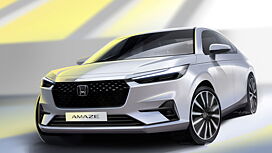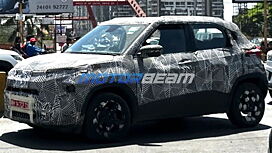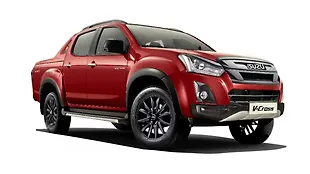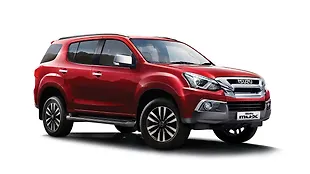Specification
Isuzu D-Max V-Cross Z 4x4 MT
Tyre size and brand: 245/70 R17, MRF Wanderer AT
Minimum ground clearance: 225mm
Off-road gear: 4WD with a low range transfer case and shift on the fly capability
Price: Rs 26.93 lakh, on-road, Mumbai
Introduction

How do you make a Jeep Wrangler and a Mahindra Thar look less imposing? You park an Isuzu D-Max V-Cross beside them. This is more because of its function as a five-people plus oversized luggage carrier, rather than the designed form.
The 1.9-litre, four-cylinder turbo-diesel engine, with 165bhp of maximum power and 360Nm of peak twist force (developed at a very low 2,000rpm), looks and sounds powerful. But with a kerb weight just 5kg shy of two tonnes, the engine needs more than mere grunt. A six-speed manual gearbox and an electronically-actuated 4WD system with low range should do the trick, along with a mechanical grip-enhancing ladder-frame chassis and long-travel suspension. Apart from a short hill-climb, there was no need to use the D-Max V-Cross’ 4L mode — the need for (relatively faster) speed for most of the gymkhana course meant we used the 4H mode.
2021 CarWale Off-Road Day performance?

The sharp left into the gymkhana arena immediately threw up its first major hurdle — visibility. The windshield and side windows are not large enough to give you a clear outside view. Add more than three metres of metal, glass, and truck-bed behind the driver’s seat into the mix and you have to be careful around obstacles, like the shrivelled but sharp branch of a dried-up tree jutting into the course. Now, the momentum is enough to easily take the V-Cross up the steep slope. But the challenge is to come to a full stop just before the apex of the slope, wait five seconds, and then move forward while also getting ready to take a sharp right to avoid the deep fall into a man-made lake on the other side.
The combination of an almost 5.3-metre overall length, front tyres pushing outward due to the 4H mode being engaged, and the disadvantage of low visibility meant taking two corrections to make the turn. And there was a trio of problems making this turn even more daunting — the steering wheel, the clutch pedal, and, most irritatingly, the gear shifter. Quick-shifting from reverse to first gear is dangerous, with no reverse-lock mechanism (which prevents shifting into reverse by mistake) and the very vague shift-gates, there was at least one instance where the D-Max threatened to spectacularly jump into the lake while I expected it to go in reverse.

A quick right and sweeping left corner later, we arrived at the shortcut — a path reserved for the D-Max, Thar, and Wrangler. The shortcut would test an off-roader’s ability to conform to the terrain, twisting the chassis, and using the full range of suspension travel to keep all the wheels on the ground — maximum traction, maximum forward momentum.
All of us at CarWale hold mechanical sympathy in high regard, so the V-Cross had to be driven with a little extra care to not bash the front bumper and the side-steps over the undulating ground of the shortcut. The tyres protested a bit, but a good line through the troughs and crests along with just enough momentum made the obstacle feel less challenging than it looked. A mini wall-ride-like section followed, and the V-Cross’ flexibility was on full display again. Watching the mirrors (with some difficulty) so that the rear end wouldn’t clip the marker cones, the huge pickup truck managed to make the obstacle look mild.

A quick dash through two sharp left turns followed by a long winding left sweeping corner in between, the finish line quickly approached in a turbocharged diesel howl. That said, the ‘All Mighty’ hulk needs better brakes to be brought to a standstill and the slow-acting ABS did help shorten the braking distance a bit. If it was by design or by luck, we do not know.
With a time of 02:05, the Isuzu D-Max V-Cross recorded the slowest time around the gymkhana track. Its immense size, low visibility, heavy controls, and inability to be driven with finesse prevented it from doing better. Of course, it could be improved with knobby tyres, by removing the side steps and adding a lifted front bumper, but in stock form, it is intended more like a large people and luggage carrier with all-terrain capability than an outright obstacle-pummelling off-roader.
Tester’s notes

- With so much torque delivered at a low 2,000rpm, most obstacles didn’t even need a lot of prodding of the accelerator pedal to be disposed of
- We didn’t dare test the limits of the V-Cross’ grip in 2WD mode, so turning circles around the tighter obstacles were slightly more elongated than ideal
- The MRF Wanderer All-Terrain tyres struggled on the loose gravelly surface

- Only the AT variant gets safety assists like ESC, TCS and Hill Descent Control, so we couldn’t test those features out
- The ABS, with its slow pulses, did lead to a relatively shorter braking distance on the sandy braking course, despite the V-Cross’ bulk
- The V-Cross’ suspension is designed to work better when carrying some weight over the rear axle. We had to take some of the obstacles slower to avoid the rear axle from bouncing up and sideways

- Twisting the large knob on the lower centre console engages the 4WD and 4WD Low modes. While shifting from 2WD to 4WD mode can be done on the fly, you have to come to a full stop and then depress the knob down before twisting it to engage the 4WD Low function
- The first couple of gear ratios on the D-Max V-Cross are short, and this is to keep the engine in its short but sweet powerband. Some of the slower obstacles could be tackled in second gear without any throttle input too
Vikrant’s take

The V-Cross finished last in the gymkhana, which was a little surprising, given how well it did in its last Off-Road Day outing. We put the V-Cross through three tests — a tight slalom, an off-road acceleration test, and an off-road braking test. The slalom test was completely different this time, with a tighter layout and loose gravelly surface instead of the slush like before. The V-Cross’ huge length meant placing it through the course was difficult without sacrificing speed and accuracy. This combined with heavy and slow steering, road-biased tyres, and a fixed 50:50 power split between the axles made the V-Cross the slowest and most cumbersome in the slalom test. The tyres also struggled to put the power down in the acceleration tests, but the ABS managed to bring the V-Cross to a stop relatively quickly.
Conclusion

There were high expectations from the Isuzu D-Max V-Cross, especially since it did so well in the previous iteration of the CarWale Off-Road Day. The gymkhana course set for the 2021 edition favoured the leaner machines more and the big burly D-Max suffered. But there’s no doubt that if you had a party of five and their luggage to take to an off-road destination, the Isuzu D-Max V-Cross would not disappoint. Of course, you would have to remove the side-steps, get better off-road centric tyres, and be ready to bully the controls into submission, but you get used to that. Get the AT version and you save yourself from what feels like a session in the gym.
Photography by Kapil Angane and Kaustubh Gandhi

![Isuzu D-Max [2021-2024] Right Front Three Quarter Isuzu D-Max [2021-2024] Right Front Three Quarter](https://imgd.aeplcdn.com/642x361/n/cw/ec/114085/isuzu-d-max-right-front-three-quarter0.jpeg?isig=0&wm=1&q=80)
![Isuzu D-Max [2021-2024] Right Front Three Quarter Isuzu D-Max [2021-2024] Right Front Three Quarter](https://imgd.aeplcdn.com/642x361/n/cw/ec/114085/isuzu-d-max-right-front-three-quarter2.jpeg?isig=0&wm=1&q=80)
![Isuzu D-Max [2021-2024] Right Front Three Quarter Isuzu D-Max [2021-2024] Right Front Three Quarter](https://imgd.aeplcdn.com/642x361/n/cw/ec/114085/isuzu-d-max-right-front-three-quarter7.jpeg?isig=0&wm=1&q=80)
![Isuzu D-Max [2021-2024] Rear View Isuzu D-Max [2021-2024] Rear View](https://imgd.aeplcdn.com/642x361/n/cw/ec/114085/isuzu-d-max-rear-view3.jpeg?isig=0&wm=1&q=80)
![Isuzu D-Max [2021-2024] Left Rear Three Quarter Isuzu D-Max [2021-2024] Left Rear Three Quarter](https://imgd.aeplcdn.com/642x361/n/cw/ec/114085/isuzu-d-max-left-rear-three-quarter9.jpeg?isig=0&wm=1&q=80)
![Isuzu D-Max [2021-2024] Left Side View Isuzu D-Max [2021-2024] Left Side View](https://imgd.aeplcdn.com/642x361/n/cw/ec/114085/isuzu-d-max-left-side-view4.jpeg?isig=0&wm=1&q=80)
![Isuzu D-Max [2021-2024] Left Side View Isuzu D-Max [2021-2024] Left Side View](https://imgd.aeplcdn.com/642x361/n/cw/ec/114085/isuzu-d-max-left-side-view5.jpeg?isig=0&wm=1&q=80)
![Isuzu D-Max [2021-2024] Left Side View Isuzu D-Max [2021-2024] Left Side View](https://imgd.aeplcdn.com/642x361/n/cw/ec/114085/isuzu-d-max-left-side-view6.jpeg?isig=0&wm=1&q=80)
![Isuzu D-Max [2021-2024] Image Isuzu D-Max [2021-2024] Image](https://imgd.aeplcdn.com/272x153/n/cw/ec/48082/d-max-exterior-right-side-view-2.jpeg?isig=0&q=80)





















